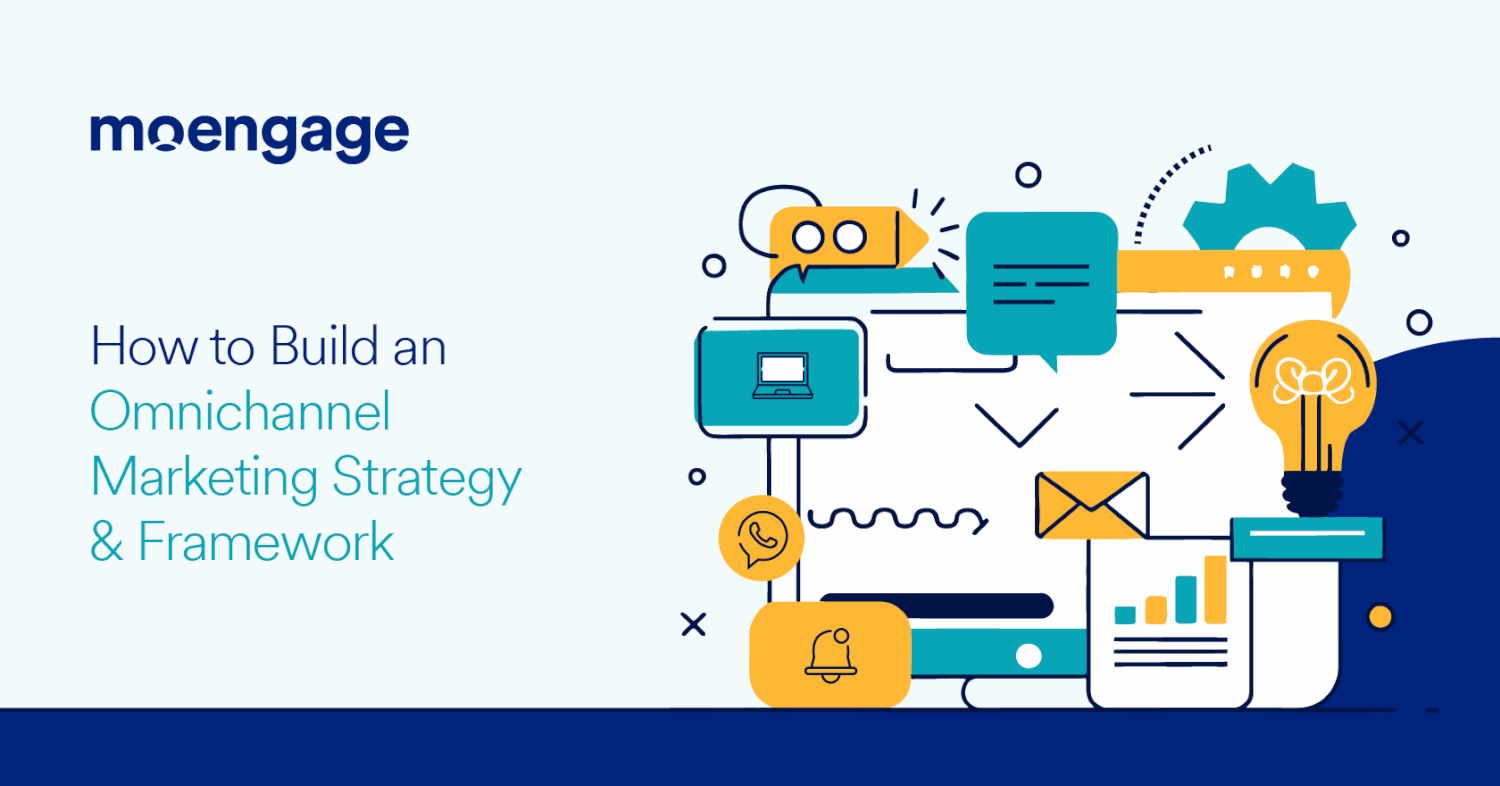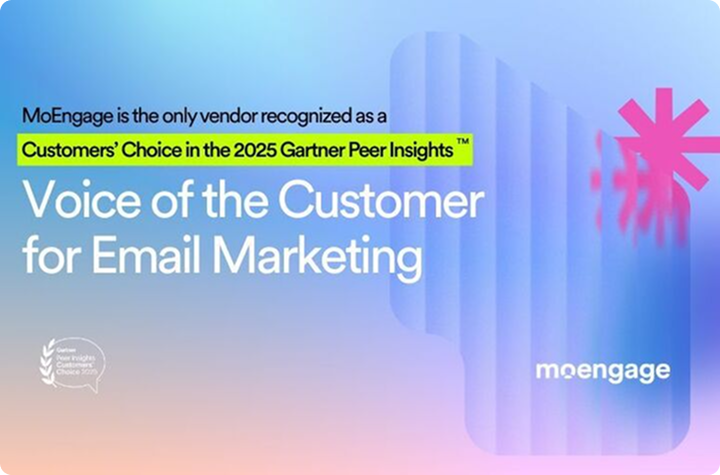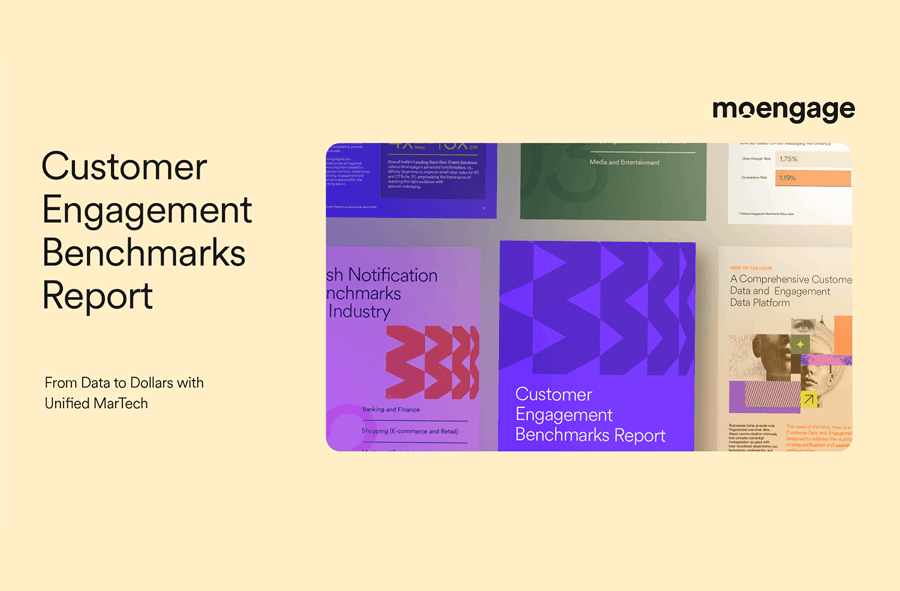How to Build an Omnichannel Marketing Strategy & Framework

Reading Time: 15 minutes
Brands operating on legacy systems know the struggle all too well: lack of automation, long go-to-marketing times, and (more importantly) a weak omnichannel focus.
Sure, you’re running campaigns across different channels, but they’re not connected in any way. Email, web push, mobile push notification, and SMS message campaigns are operating entirely independently of each other.
The problem is that your messaging overlaps, timing is never on point, and the customer journey isn’t fluid. This leads to a clunky, lackluster, and overall poor customer experience.
Instead, you need to connect these disparate channels and take an omnichannel approach to your engagement strategy. This means consolidating and unifying your data, coordinating all channels and touchpoints, and orchestrating seamless journeys that make it easier, faster, and more convenient for your customers to do — well, whatever it is you empower them to do.
To help you deliver smooth, seamless experiences and campaigns your customers love, we’ll walk you through the process of building an effective omnichannel marketing strategy and framework that leverages all relevant touchpoints and actively engages your customers.
Let’s get to it.
What is an Omnichannel Strategy?
In marketing, an omnichannel strategy is a tactic that involves creating a unified, cohesive experience for customers across all channels and touchpoints. It involves integrating online and offline channels seamlessly to create a familiar experience for customers that maximizes engagement and retention.
Why do brands need to take an omnichannel approach?
An omnichannel approach enables you to create seamless customer experiences that meet customers where they are, collect comprehensive customer behavior insights, and reallocate your resources for more efficiency and better returns.
Customers expect brands to meet them where they are; on their preferred channels and at the ideal time. When they get this level of attention, they are more likely to engage (and buy!). Ultimately, this is a major reason why taking an omnichannel approach to B2C customer engagement is vital.
The interconnectivity that an omnichannel strategy offers reduces friction at points of conversion. It also provides a clearer picture of the customer journey from beginning to end, illuminating areas where a brand can stand to improve.
How does an omnichannel strategy improve customer experience?
Omnichannel strategies are customer-centric by design. Every facet of omnichannel has the potential to uplift the customer experience and their perception of your brand.
Omnichannel marketing strategies improve the customer experience in the following ways:
- Ensures a consistent and cohesive brand experience across all touchpoints: An omnichannel strategy ensures customers get a familiar, uniform experience no matter how they interact with your brand.
- Allows brands to engage meaningfully throughout the customer’s journey: With multiple channels at their disposal, brands can perfect channel selection and message timing to connect with their audience.
- Enables brands to personalize the customer’s experience: With more channels available to connect, brands open up a variety of ways to personalize the experience based on their customer’s preferred channel(s), message timing, and delivery frequency.
- Empowers brands to be proactive instead of reactive: Omnichannel data gives brands a window into customer behavior that lets them not only react to customer activity, but also predict a customer’s propensity to convert or churn and engage with them proactively.
- Guide customers effectively toward conversion events: Using the right sequence of channels and messages helps brands effectively and efficiently lead customers toward a conversion, whether that’s a purchase, subscription, or app download.
- Gain deep customer insights: Access to unified, omnichannel analytics provides brands with deep insights that empower them to understand customer behavior and fuel their campaign optimization efforts.
- Effectively allocate resources to the right channels: By understanding omnichannel engagement, brands can prioritize the right channels for their campaigns and optimize channel selection to maximize engagement.
- Enhance brand visibility and recognition: An omnichannel strategy increases brand visibility by ensuring you’re accessible via the channels your customers use, helping you with acquisition, conversion, re-conversion, and retention.
Ultimately, an omnichannel strategy provides brands with valuable insights into customer behavior. This allows them to understand their customers deeply, meet them where they are, and actively engage with them across channels.
Top Goals of an Omnichannel Strategy
When considering the value of omnichannel, it is important to address the common goals of an omnichannel strategy and how they may be aligned with your brand.
When leveraged properly, an omnichannel strategy can help you achieve the following goals:
- Be insights-led in your approach to customer engagement: Deeply understand customer engagement based on a holistic view of all their interactions with your brand. This will help you identify what they like/dislike and what motivates them to engage with your brand.
- Be customer-centric instead of brand-centric: Modern consumers expect an experience that’s designed around their needs and preferences, not your organization’s. Building customer-centric experiences and campaigns empowers brands to increase customer satisfaction and drive engagement.
- Improve the overall customer experience: Customers get a seamless, familiar experience across all channels and touchpoints, making it easy for them to navigate and use your service no matter how they choose to interact. Customers are also far more likely to engage when they get relevant communication on their preferred channels.
- Enhance and elevate customer engagement: Brands use omnichannel strategies to increase traction at every touchpoint by optimizing channel selection, delivery timing, and message frequency. This goes a long way in increasing customer engagement and retention.
- Boost conversions and repurchases: An omnichannel strategy empowers you to connect with customers across a myriad of touchpoints seamlessly. This means you can leverage web push, in-app messaging, mobile push notifications, SMS messages, etc., to create customized customer journeys that lead customers toward conversion events (and get them to come back and buy again).
- Foster brand loyalty and advocacy: With orchestrated omnichannel campaigns that meet customers where they are at the best times with the optimal messaging, brands are able to build deep, meaningful, and long-lasting relationships with their customers, which leads to greater customer lifetime values.
Omnichannel marketing strategies aim to increase customer satisfaction, with the belief that this will, in turn, lead to greater engagement, higher conversions, and improved retention. By making data-driven decisions from a customer-centric perspective, brands will be able to leverage omnichannel marketing efforts to increase traction with customers.
How to Create an Omnichannel Strategy: A Step-by-Step Guide
Now that you have begun thinking with the omnichannel mindset, we can tackle the step-by-step process of building an omnichannel strategy for any brand, regardless of size, industry, or intended audience.
1. Identify your customer’s priority platforms
First, it is important to look at the channels and devices that your existing customers are using most to engage with your brand. Explore how they interact with your brand and evaluate the current overall customer experience so you can identify customer preferences and pain points.
Businesses want to review and identify how current, cross-channel customer actions are shaping the funnels toward conversion touchpoints.
What channels are your customers gravitating towards?
Why are customers choosing certain channels?
It may be as simple as certain channels being more popular with certain demographics, but it could be rooted more in whether or not the service is convenient, accessible, and intuitive for your customers.
Either way, this will allow you to identify which channels your customers prefer so you can optimize your omnichannel strategy to leverage the channels your customers prefer most.
2. Develop buyer personas that reflect your intended audience
To acquire new customers, you need to convince them you understand them and can meet their needs and expectations. Buyer personas allow you to effectively connect with your ideal customers and craft unique campaigns that capture their attention.
Buyer personas should take into account demographic characteristics, customer behavior, buying habits, preferred modes of communication and devices, and any other notable activity patterns.
Think granularly about what each persona cares about: Who are they? What do they want from your service or products? What frustrates them the most? Why do they buy from you?
All of this will help you think critically about what motivates this particular buyer persona to choose your brand over your competitors, allowing you to craft campaigns that convey what differentiates you and the unique value you offer.
3. Segment your audience based on behavior and intent
While buyer personas are about examining the ideal customer, segmentation breaks down current customers into groups that are aligned by certain characteristics for the purposes of personalization and real-time interactions.
Segmentation empowers improved personalization efforts, which is especially important in the modern market, where 71% of customers express frustration when a shopping experience is impersonal.
Customers can be segmented by their location data, their browsing behaviors, or aligned by levels of loyalty or engagement with your brand. In an omnichannel strategy, this allows brands to optimize channel selection and perfect campaign messaging at scale for even large enterprise brands.
Segmentation is also an effective way to isolate customers who are at risk of dropping off or going dormant so that event or behavior-based triggers can be applied to re-engage them.
4. Map your customer journeys based on real-life engagement
Now that you know who you’re targeting, you can begin to craft personalized customer journeys that leverage the preferences and habits you identified.
To really understand how your customers engage and meet them where they are, create detailed customer journey maps that factor in each touchpoint (both online and offline) your customers could use, every possible type of interaction, and the different potential sequences.
This will enable you to streamline and enhance the customer journey, mitigate pain points, and reduce friction, allowing you to drive engagement and retention.
Keep in mind that individual customers will behave differently, and may take different pathways. Even single campaigns could have multiple pathways for customers across both online and offline channels.
For brands to maximize engagement, they’ll need to weave these pathways together so the process is familiar and seamless no matter which journey the customer takes.
5. Seamlessly integrate all channels and systems
Now that you have defined the scope of your customer interactions across priority channels and devices, this cross-channel scaffolding will support the construction of your cemented omnichannel framework.
Apply revelations from the customer journey mapping step to ensure supportive connections between the checkpoints that customers are hopping on and off from on and offline.
Consider the common tendency for customers to browse digitally before proceeding to brick-and-mortar locations to assess and purchase. Engage with the why of these events that you have discovered from the prior steps so that you can take advantage of opportunities and support what drives your customers to interact and remain engaged.
From reading about your store online to visiting the physical location to making a purchase through your mobile app — regardless of the order of such events, you will have to ensure that the customer experience remains uniform throughout.
6. Prioritize Customer Support
Two out of three customers have reported abandoning a brand due to poor customer service. Customer support is an integral part of a cohesive omnichannel strategy. It is important not to overlook this element in favor of the sales, advertising, and marketing aspects of business.
Regardless of the platform, customers need to receive quality support when they initiate communication with your brand. Consistency and transparent access with clear steps to support are significant to the overall impression you leave your customers with.
Once omnichannel has reshaped your brand’s customer interactions, we recommend the following additional omnichannel best practices to further elevate the experience for your audience.
10 Omnichannel Strategies & Best Practices to Integrate With Your Marketing
Omnichannel marketing relies on intentionality and the willingness to be creative with your strategies. Interconnectivity reveals new opportunities within every aspect of your modern marketing plan if you are willing to take advantage of them. The following strategies reveal opportunities for you to make the most of your omnichannel implementations.
1. Prioritize mobile experiences first
Mobile access to technology has fundamentally changed the way we live, making it more convenient for consumers to access products and services they love. In fact, in the last few years, smartphone usage in the US has grown dramatically, with daily online smartphone activity reaching 3 hours and 50 minutes in 2023.
And this is only expected to grow, with eMarketer predicting that by 2025 daily online smartphone activity will reach 3 hours and 58 minutes.
Consumers are also prioritizing mobile apps, with adult smartphone users spending an average of 4.37 hours per day using mobile apps. Whether consumers prefer a mobile website or a mobile app, a brand’s mobile presence is essential for engaging modern consumers.
Brands looking to build an effective omnichannel strategy will need to ensure they prioritize mobile engagement. For most audiences, this should be the primary channel, and mobile experiences should be woven throughout most customer journeys to maximize engagement with your campaigns.
An optimized mobile-friendly website that prioritizes a smooth user experience is now a minimum requirement. Most brands would benefit from taking this a step further by optimizing their mobile experiences or even developing native mobile apps that allow them to collect zero-party and first-party data.
2. Leverage all available customer touchpoints
An omnichannel strategy is all about unifying various customer touchpoints to create a seamless, cohesive experience for customers no matter how they interact with your brand.
Make use of as many relevant channels as you can to offer customers the touchpoints that suit them most. This allows you to connect with customers via their preferred channels, drastically increasing open rates, click-through rates, and overall engagement.
3. Maintain consistent messaging & branding
While you do want to leverage each channel’s unique features to maximize engagement, you also want to make sure that your messaging is consistent across all channels and campaigns. This will help you ensure that your campaigns and overall customer experience are consistent and familiar no matter the touchpoint your customers use.
The more consistent and familiar your messaging is, the easier it will be to build brand recognition and differentiate yourself from your competitors. For this, you must regularly revisit your messaging and ensure that it’s standardized across all the channels you’re using.
Also, you need to ensure that the messaging you use is continued between the channels.
For example, if a customer abandons their cart on your shopping app, the message you send them on their email should be geared toward reminding them to complete their purchase.
4. Craft intentional content for each platform
To make the most of all the channels you’re using in your omnichannel strategy, you want to leverage each channel’s unique features and capabilities.
Consider the strengths and weaknesses of the channels you’re using, and lean into what makes those channels most appealing to consumers. For example, emails can use dynamic content and images, while mobile push will be far more copy-reliant.
Craft your content intentionally to make the best use of the channel and deliver what your customers expect, leveraging the unique features of the channel to make your content more engaging.
5. Design content around the customer’s journey
An omnichannel strategy isn’t about bogging customers down with an abundance of messages across all channels; instead, it’s about delivering the right message at the right time in their journey.
An effective omnichannel strategy makes the most of all available touchpoints by ensuring campaigns are built around the customer journey and designed based on how customers interact with your products, service, and brand.
Even the most interesting, eye-catching campaigns will fail if they never reach your customers. It’s imperative that brands design their campaigns to fit neatly into the customer journeys they’ve defined in order to maximize the impact of each interaction and increase traction and engagement.
Top B2C brands will also use this chance to personalize elements of their campaigns and the overall customer journey, ensuring customers get unique value from your communication.
6. Use event-triggered, real-time alerts and campaigns
Inundating customers with messages that don’t apply to them no longer works; in fact, it can actually annoy customers and lead them to churn. Modern consumers expect their messages to be relevant to them and their individual needs.
Brands looking to maximize engagement using an omnichannel strategy will want to deploy real-time messaging that automatically triggers based on customer activity. This empowers brands to serve contextually relevant messages to their customers when they need the communication most.
For example, brands can send transactional alerts that keep customers in the loop. When leveraged properly, event-triggered, real-time alerts enable brands to enhance the customer experience, increase engagement, and drive conversions.
7. Make every touchpoint “shoppable”
Modern consumers are looking for direct, seamless experiences when buying products, and brands need to do all they can to eliminate friction and make those experiences faster and simpler for their customers.
B2C marketers should use an omnichannel strategy to capitalize on every opportunity to make a conversion convenient, whether it’s a purchase, an app download, or a subscription.
Make every possible touchpoint shoppable, including web, mobile, social media, and more. The more options customers have to convert, the more likely they are to engage and buy.
For instance, as part of your SMS strategy, you can set up a dedicated shortcode that customers can text to initiate a shopping experience. Customers can text a specific keyword to the shortcode to receive product information or a link to a mobile-friendly shopping page on your website.
8. Optimize campaign performance with A/B testing
Your campaigns won’t acquire and retain customers effortlessly; they’ll require consistent reviews and updates to ensure they’re optimized to maximize engagement.
Consistently test your campaign performance to identify areas of improvement, and then leverage the insights you gather to improve engagement and retention.
Use dynamic A/B testing to compare the performance of different campaign elements, including channel selection, delivery timing, message frequency, and more. Isolate what channels and campaigns your customers love, and then optimize accordingly to ensure you’re making data-driven decisions that lead to greater engagement.
9. Invest heavily (and wisely) in your tech stack
Executing an omnichannel strategy that drives customer engagement is no easy task, it requires many different components to be fully aligned, including channel selection, message frequency, and personalized content.
In order to manage all these elements, B2C marketers need to invest in developing a tech stack that will support these efforts. One of the most essential components of their tech stack is a Customer Engagement Platform (CEP) that helps teams manage and execute their omnichannel strategy effectively.
The right CEP will provide you with omnichannel analytics that power insights and data-driven improvements to your campaigns, marketing automation that allows you to execute personalized campaigns at scale, and real-time notifications that activate customers at the optimal time.
10. Ensure customer data is secure
Omnichannel interconnectivity relies heavily on actionable customer data, including demographics, location information, and actual behavior. But with this comes data privacy and security requirements that demand companies adequately protect this consumer data.
Failure to keep customer data secure can have significant implications in terms of direct fines and penalties, but it can also have a serious impact on your brand’s reputation.
It’s critical that marketers do all they can to keep customer information protected in accordance with all data privacy regulations to maintain their audience’s trust — and their business.
An Omnichannel Strategy Example
Omnichannel marketing involves using every touchpoint available to engage with your customers. This means creatively orchestrating the flow of the customer journey to nudge customers further along the funnel and help them complete conversion events using the different channels at their disposal.
Let’s illustrate what those baton passes between channels can look like across the customer experience with a detailed example.
A customer sees a digital ad for one of your featured products on a social media platform and is exposed to your brand for the first time. After clicking on the ad, they are redirected to a website landing page, which contains product information, delivery details, ratings, and reviews for the product they are interested in.
They add the item to the cart but get distracted before they complete the order and confirm payment.
Now that you have their personal email, you can actively reach out in an attempt to reactivate the customer and recover the abandoned cart. Two days after the customer abandons the cart, you send them an email reminding them of their incomplete order.
The message connects them to the abandoned order, offers them a discount to complete the purchase (via free shipping, a reduced price, or a free trial period), and recommends related products that are personalized based on the items they were browsing for.
The customer completes the order with a higher order value than they had originally intended and requests the in-store pickup option.
To improve the customer experience (and increase the customer retention potential), you follow up via email and ask the customer to download your mobile app and create an online profile, so you can send them real-time status updates on their order.
But you don’t stop there; you then follow up post-purchase with in-app messaging and mobile push notifications that increase in-app retention and overall brand engagement.
Using the customer data you have, you deploy personalized campaigns based on their customer segment and previous activity, connecting them with contextually relevant recommendations and offers that incentivize engagement.
Eventually, the customer returns to make a second purchase, where you try to cross-sell them with complementary products. Following this, you send an email to the customer requesting that they complete a survey and leave feedback about their experience.
You can then use this feedback to not only improve future communications with this individual customer but you can also make improvements to your campaigns that more effectively engage and retain customers at each step in their omnichannel journey.
As you can see, to effectively execute an omnichannel strategy, brands need to seamlessly integrate channels so they have smooth hand-offs.
Now that this customer’s interactions have crossed all of the priority channels and their behavioral data have been fully integrated, the brand can best support them with relevant and well-timed offerings for additional products and services based on these observed and recorded customer preferences and behaviors.
The customer can also be prompted to provide feedback for opportunities for improvement for the business and to continue to keep the brand top of mind for the customer.
As your efforts draw in customers old and new, you will want to monitor how they are being affected by the proactive strategies you are applying.
Measuring the Success of Your Omnichannel Strategy
To best understand customer interactions and determine your brand’s success, you need to be able to consistently measure your performance. Having robust omnichannel analytics allows you to analyze minute details about customer engagement, helping you understand what drives traction with your brand.
Below, we cover some of the core key performance indicators (KPIs) for measuring the success of your omnichannel strategy.
- Conversion Rate: This is the percentage of customers who complete a conversion event, such as newsletter opt-ins, account sign-ups, subscriptions, or purchases. In an omnichannel context, it’s used to reveal which channels are performing optimally and eliciting the customer interactions that you want.
- Average Order Value (AOV): This is the average value of each order your customers place, whether that’s a purchase, a delivery order, or a subscription. The AOV is a solid indicator of which channels are running effective upselling and cross-selling campaigns.
- Customer Retention Rate: This is the number of customers remaining after a measured period of time. It’s an indication of a brand’s ability to keep customers engaged, as well as a strong signal for long-term growth and heightened brand loyalty. In an omnichannel context, the customer retention rate helps brands determine priority channels and select channels for individual campaigns, as well as maximize their campaigns for greater engagement.
- Churn Rate: This is the percentage of customers that a brand has lost in a measured period of time. It is the inverse of the customer retention rate. The churn rate is a strong indicator of friction, a poor experience, and general customer dissatisfaction. With an omnichannel strategy, the churn rate helps brands determine which channels have the greatest drop-offs, identify where those drop-offs are occuring, and fuel targeted improvements that stop abandonment.
- Customer Lifetime Value (CLV): This is the total amount the average customer will spend throughout their entire lifecycle with your brand. Brands commonly use this to determine the true value of each customer acquisition, as well as make related decisions about marketing spend. In an omnichannel context, it can reveal which channels and campaigns are generating the highest-value customers.
Build an Engaging Omnichannel Marketing Strategy With MoEngage
To attract and retain customers, brands need to be able to meet customers where they are, communicating with them with the right messaging and via their preferred channels. Communication can’t be about what’s best for the brand, it needs to be customer-centric, designed to elevate their experience.
An omnichannel marketing strategy ensures that brands can apply important tools like hyper-personalization and segmentation at scale and continue to track results to further their goals. Omnichannel tactics reveal a wealth of actionable information that helps brands determine where to allocate their resources and what elements of their campaigns to optimize.
With all data consolidated, MoEngage’s Omnichannel Marketing Platform empowers brands to build campaigns intuitively from a single interface, saving them time (and headaches!).
Schedule a demo today to learn how MoEngage can help you lay a solid foundation for your omnichannel marketing strategy and deliver consistently engaging campaigns to your customers.


















